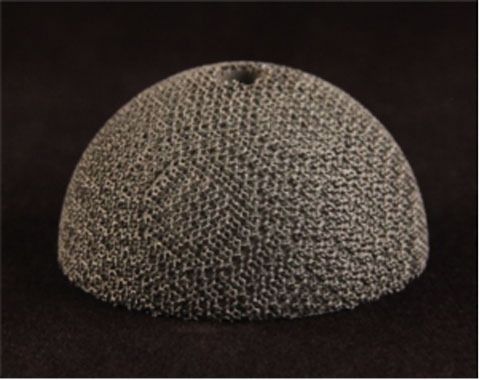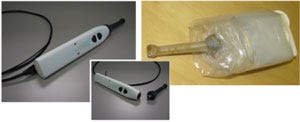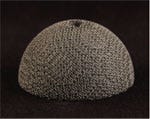What are the best uses for 3D printing in medical devices today?
May 1, 2015

What are the best uses for 3-D printing in medical devices today?
Andy Pfahnl, ScD
The medical device industry is embracing 3-D printing for a range of applications that include true medical devices and clinical use, and not just for medical or health-related products. We look at the three top reasons to consider 3D printing for medical devices by examining specific applications best suited for the state of the additive manufacturing technology.
Background
Medical devices are regulated and categorized according to risk level, which in general reflects the rigor required in their development. The adoption of 3-D printing for medical devices is in part gated by the rigor in verification and validation of designs and processes that are required with particular consideration of mechanical and thermal properties, and biocompatibility. There are several different 3-D printing methods for both metal and plastics. They all inherently involve fabricating the part one layer at a time. For plastics there are more material options and fabrication methods that require careful consideration of temperature properties and mechanical bulk properties given changes the layering can have.
Top 3 Applications
Adoption and use of 3-D printing will be driven by the rigor and development efforts in each of these areas, which ultimately defines the best uses today for 3-D printing in medical devices. The best 3-D printing medical device applications include external wearable devices such as external strap-on braces, clinical study devices, and orthopedic implants.
1.External wearable devices
Wearable mechanical braces are well suited for 3-D printing because they are devices that are ideally customized to fit each patient. In these cases, 3-D printing is often accompanied by 3-D scanning to help create the geometry. Devices that can be attached to the outside of a person generally can be made much larger or thicker than say surgical devices or implants that have to reach into a body. This helps overcome any mechanical strength issues with 3-D printing. However, the intended use and consequential force and load requirements must still be understood and defined to achieve a suitable device design.
Biocompatibility requirements can be assessed by referring to ISO 10993-1. For these devices the “nature of body contact” falls within the “surface device” category with skin contact limited to unbreached skin. The contact duration is based on the healing period which is typically six to eight weeks. This puts the device’s contact duration in the Permanent category (> 30 days). The resulting Biological Effect that needs to be assessed are Cytotoxicity, Sensitization, and Irritation or Intracutaneous Reactivity.
The amount of actual experimental testing needed depends on the biocompatibility information available for the materials used to construct the brace, and the materials used in the fabrication processes (e.g. solvents). Initiatives like the Biocompatibility Consortium for Additive Manufacturing, headed by professor Allison Hubel at the University of Minnesota, are underway to help create standards for assessing and validating 3-D printing processes for specific challenge geometries to minimize the amount of testing as a way to improve industry adoption of these processes.
Examples of mechanical braces and development efforts can be readily found and include finger splints (including by 3D4MD), orthotics (SOLS Systems), and cast replacements. Predictive performance characterization of an anisotropic mechanical properties will be important as new applications will demand load bearing capability such as a wearable mechanical brace for scoliosis patients that was recently described .
2.Clinical Study Devices
Another application well suited for 3-D printing is for creating devices for clinical studies where build quantities are low and design changes after evaluation are likely. Today “me-too” evolutionary type products find less value in the market place, and the medical industry has a renewed appetite for innovative and disruptive technologies that require clinical evaluation. Feasibility and first-in-human (FIH) studies typically involve a low number of patients (e.g. 10–30) with the anticipation that the device design may change. For a device with multiple plastic components, 3-D printing offers a cost effective way to create clinically usable parts without the cost ($10,000–$30,000+) and development time (4–8+ weeks) of injection mold tools. For validation or pivotal studies where the patient study size is on the order of hundreds of patients, 3-D printing offers a means to conduct the study earlier in the development process while production tools and components are still being developed and readied.
So, short-term use devices, applications with low build quantities, and devices where structural integrity is not demanding such as enclosures, are ideal. The key to using 3-D printing is to also include final manufacturing features such as draft angles when production molding is anticipated, as these details can affect the final design fit and performance.
|
Novascan breast cancer detection technology was developed using multiple rapid prototype methods. |
One example that uses multiple rapid prototype methods is for a clinical study device of an intra-operative surgical tool for the real-time assessment of a surgical excision margin for the presence of cancer. This technology by Novascan was developed into a disposable patient-contacting tip and a reusable handpiece that housed electronics. The patient contacting tip is a two-piece housing that is made with a biocompatible SLA material. The tip was subjected to a prescribed cleaning process, and underwent sterilization and biocompatibility testing. The handpiece housing is made with Polyjet technology. The body of the housing is made with a rigid Objet plastic and the integrated button covers and cable strain relief with Objet digital materials to create a compliant elastomeric type property. These materials are not inherently biocompatible, and consequently a qualified surgical draping system common to ultrasound probes was integrated into the disposable tip. The hand piece could then be presented to the person in the sterile field who then snaps on the tip and pulls the drape over the reusable non-sterile device just like an ultrasound probe.
3.Implants surface texture - Complex geometry
Finally, one area that has found excellent adoption in production manufacturing is in orthopedics and dental. Here, metal additive manufacturing processes of laser and electron beam melting processes are used. ASTM F2924–14, "Standard Specification for Additive Manufacturing Titanium-6 Aluminum-4 Vanadium with Powder Bed Fusion," is a standard that has been established to define requirements and how material properties of components made with these methods are evaluated for a specific metal.
|
This Titanium alloy (Ti-6AI-4V) acetabular cup with porous surface was fabricated using 3D Systems Direct Metal Printing (DMP) technology. |
A key performance aspect of orthopedic implants is fixation in the bone. The fixation approach started with cement, but over the years moved to cementless fixation by texturing the surface of the implants to create high-friction and bone ingrowth opportunities. The benefits with additive manufacturing are that the effective porosity can be controlled throughout the build, the thickness of the ingrowth area controlled and increased, and the manufacturing completed all in one process versus as a separate application of the texture to the surface of the implant. In this way, true solid constructs can be built and then transitioned to a defined porous surface structure that benefits bone ingrowth. The inset picture shows a state-of-the-art manufacturing method from 3D Systems. The material—whether it is Titanium or another suitable metal—has the same composition as bulk implant-grade material. Cleaning processes are well defined for metal implant and instrument components and applicable to the additive manufactured devices as well.
Future of 3D Printing…
The use of 3-D printing in medical devices has been growing. Metal additive manufacturing has seen adoption into commercial production of orthopedic implants. Plastic 3-D printing applications are in use for enclosures, external-type device components and clinical study applications where mechanical load-bearing requirements are low, manufacturing quantities are low, and customization is desired. Materials will continue to be an important element in the adoption and growth of 3-D printing. Tissue and regenerative medicine has been a topic of research, but here too, production manufacturing equipment for clinical use is in development that will give the medical device community an entirely new way to think about creating devices.
Want to learn more about 3-D printing? Andy Pfahnl, ScD will be speaking at the MD&M East Conference, June 9–11, 2015, in New York City. |
Andy Pfahnl, ScD is CTO of Devicix (www.devicix.com), which is an international contract medical device product development and commercialization company with brand divisions: www.iomedx.com and www.orthopedx.com. His expertise is in business development, commercialization and regulatory strategies, and product architecture development across a broad range of clinical areas including Neuromodulation / Stimulation, Cardiology, mHealth / Telemedicine, and Orthopedics. He teaches at the University of St. Thomas, and previously held management and engineering leadership positions at Amphenol and Teradyne, and was an adjunct faculty at the University of Massachusetts. He holds doctoral and master's degrees from MIT, and completed his bachelors at Rensselaer with studies at the ETH-Z.
[First image courtesy of Novascan LLC. Second image courtesy of 3D Systems]
You May Also Like




